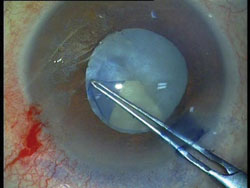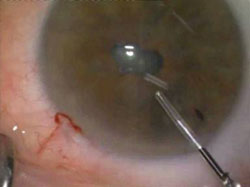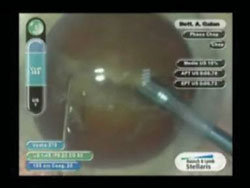Microincision technique most effective approach to cataract surgery, surgeon says
Proper equipment may make even difficult cases feasible.
 Alessandro Galan |
Cataract surgery should be performed by microincision, no matter how difficult or complicated the case is, according to one surgeon.
“[Microincision cataract surgery] is nowadays the gold standard. Quarrelling on 3.2 mm or 2.7 mm is wasting time on obsolete matters. There is no reason why we should not perform MICS in all cases,” Alessandro Galan, MD, OSN Europe Edition Editorial Board Member, said.
The best microincision cataract surgery (MICS) technique, he said, is coaxial with a 2-mm microincision, known as C-MICS. A 1.8-mm incision is possible, but 1.9-mm or 2-mm incisions are just as effective and potentially more comfortable to perform, Dr. Galan said.
“There is no point in pushing it too far. A comfortable-sized incision and the proper phacoemulsification machine are the key to success,” he said.
Complicated cases are no exception, according to Dr. Galan.
“Far from being a limitation, the smaller incision and shorter tunnel facilitate surgery because at all stages you operate in a more stable chamber that allows you to move more easily and safely with your instruments. In addition, surgical trauma and astigmatism are greatly reduced. And you don’t need to change your surgical technique,” Dr. Galan said.
Benefits of C-MICS
The C-MICS incision is tight, with a lower bottle height that allows for sufficient irrigation in a completely closed chamber, creating no turbulence, leakage or IOP variations. About half of the fluid normally needed for conventional phaco is used. Flow, vacuum and ultrasound time are dramatically reduced. The surgeon is able to work with the ideal fluidics for complicated cases, such as zonular laxity, floppy iris syndrome, pseudoexfoliation syndrome and shallow chamber, Dr. Galan said.
In case of zonular laxity, the reduced flow prevents the crystalline lens from moving backward and forward and from creating the dangerous situations that often occur during conventional phaco, for instance, in highly myopic eyes.
 Capsulorrhexis with trypan blue in white cataract. |
 Cataract surgery in eye with small pupil, posterior synechiae and low chamber. Images: Galan A |
 Cataract surgery in eye with pseudoexfoliation syndrome and insufficient mydriasis. |
 Hard nucleus, total amber cataract. |
Intraoperative floppy iris syndrome is more easily managed, because the lower and smoother fluidic current decreases volatility in the anterior chamber and prevents the iris from billowing and coming up to the phaco tip. Furthermore, the smaller tips are unable to engage the margin of the iris, Dr. Galan said.
Pseudoexfoliation syndrome leads to an increased risk during cataract surgery with regard to zonular dialysis, rupture of the posterior capsule and luxation of the lens into the vitreous as a consequence of insufficient zonule. Again, the better fluidics control and chamber maintenance greatly reduce this risk, he said.
A shallow chamber is usually a challenge, because surgical maneuvers are cumbersome and potentially dangerous within such a reduced working space. To provide a wider margin of safety, some surgeons perform a limited anterior vitrectomy to deepen the anterior chamber.
“The stable fluidics balance and the tight chamber that you have with C-MICS leads to a spontaneous dilation of the space, and you can perform your maneuvers safely,” Dr. Galan said.
Difficult cases
MICS is perfectly feasible with hard nuclei, but the proper phaco machines must be used, Dr. Galan said.
“So many surgeons gave up MICS in these cases because the phaco tip kept clogging up. It is important to realize that the problem was, with no exception, the machine, not the technique,” Dr. Galan said. “You need to upgrade your technology. There is no point in wanting to use a new technique with old instruments.”
Modern phaco machines deal well with hard nuclei. The new tips can easily and efficiently emulsify hard nuclei without becoming clogged. In addition, because they are thinner, they can also crack the nucleus more easily.
“You’ll find that you can deal with hard nuclei even more efficiently than you did with conventional phaco and 1.9-mm tips,” Dr. Galan said.
Small incisions, small tips and reduced fluidics also help in dealing with small pupils. In those cases, the advantages of a steady-sized iris and deep chamber allow for safe results, he said.
Finally, in eyes that have previously undergone radial keratotomy, small incisions are crucial to maintain the integrity of the cornea as much as possible.
“The incision can be performed in the periphery, at the limbus, in between the [radial keratotomy] cuts, without intersecting them,” Dr. Galan said. “Such cases are rare, but it’s good to know that we have a better way of dealing with them now. … Small is beautiful. C-MICS is easier and safer than standard phaco. We should no longer discuss if and when to perform C-MICS, but just make it become our standard procedure.” – by Michela Cimberle

- Alessandro Galan, MD, can be reached at Ospedale Civile Sant’Antonio, Via Facciolati 121, Padova, Italy; 39-049-8216780; fax: 39-049-8216541; e-mail: alessandro.galan@gmail.com.
